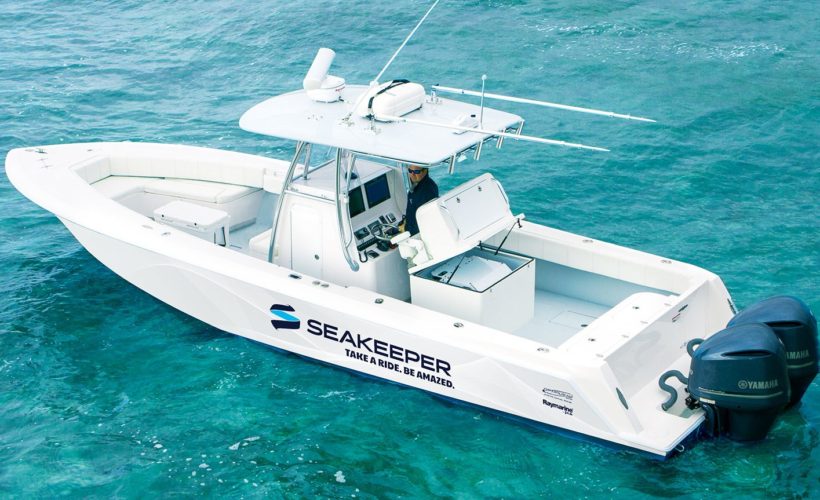The sun has burned through the early morning marine layer, and the breeze is gentle and warm enough for me to abandon my hoodie. It looks like a perfect day to head out onto the Pacific Ocean. But as soon as we exit the harbor walls at Marina Del Rey, near Los Angeles, the 29-foot sport-fishing boat starts to heave.
“We have some great waves out here today,” says Kelsey Albina, one of my guides for the day. I’m glad I haven’t had lunch yet, I think, as we thrust through waves, rolling from side to side. Then the captain taps a touchscreen on the helm. Like a movie set at lunch time, everything seems to freeze. The swaying stops. I can stand again without clutching the railing. The boat still rocks gently front to back as it crests and descends each wave, but the violence of a moment ago is gone.
I walk steadily to the back of the boat and look under a deck hatch to see the device responsible. In what would have been empty, or storage space, a white metal version of a beach ball sits suspended in a cradle. Inside that, a 500-pound, doughnut-shaped flywheel is spinning in a vacuum, clocking 8,450 revolutions every minute. This gyroscope, about the size of a large microwave, is keeping the large boat stable—a boon for sailors (like me) who don’t have their sea legs yet. This is the Seakeeper, made by the company of the same name.
Any spinning object works as a gyroscope, moving to counteract any force that tries to change its orientation. That’s how a spinning top stays upright, even when flicked. Such freaky physics makes gyros ideal for stabilizing satellites or, in miniature, for guidance on ships and missiles, where they provide navigation systems with a steady frame of reference. The designer of the 1967 Gryo-X used one to make the narrow vehicle stand on two wheels. The Gyrowheel offered the kids of 2011 a way to ride a bike without training wheels. (You won’t find either for sale today.)
Here, Seakeeper’s gyro serves to keep things steady on the high seas. As the boat rolls left or right, the gyro swings forward and backward in that cradle. That delivers torque, or rotational force, to the port or starboard, counteracting the motion of the entire boat. (You can try an experiment for yourself—sit on a swivel chair and hold a spinning bike wheel in front of you, like these folks at the University of Texas.)
A braking mechanism uses accelerometers to monitor the gyro’s swivel speed and slows it down in especially rough seas to stop it slamming from side to side. “We synchronize the gyro with the waves so we get a nice, stable, corrective force,” says Nick Troche, Seakeeper’s manager of new product development.
A couple of black hoses pipe cold seawater through a heat exchanger to keep the bearings on the flywheel cool. The whole thing can be bolted or even glued into place in a boat made of wood, metal, or fiberglass. The Maryland-based company has sold about 6,000 units, both as retrofits to existing boats and as factory-installed options on new vessels. The flywheels come in various sizes for monohull boats (sorry, no catamarans) from 25 feet to more than 85 feet long. The unit can slot into any spare space under the floor or in a locker; it doesn’t even have to be on the centerline of the boat to work. It takes about 45 minutes to spin the flywheel up to working speed, but once it’s going, you can leave it running for days, particularly if the boat is hooked up to shore power, so it won’t drain the boat’s batteries.
Staying level might, however, drain your bank account: Seakepeer’s system costs at least $22,000, and runs up to $200,000, depending on size. But if you can afford a boat, you can likely afford this thing. Troche’s team is working to make smaller and cheaper versions for shorter boats.
Other approaches to stabilize boats have relied on a kind of active suspension, like Velodyne Marine’s Martini 1.5, designed to make high-speed boating safer, which could be crucial in search-and-rescue operations. (Its creator is Dave Hall, the guy who made the first lidar for self-driving cars.)
As I relax into enjoying the now stabilized boat ride, I wonder who Seakeeper’s customers are. For anyone who takes pride in their boating skills, it seems like cheating. But pretty much everyone who tries it likes it, says Berkeley Andrews, who manages West Coast sales for Seakeeper. “It changes the game for everyone on the boat, as far as comfort, safety, and the performance of the vessel,” he says. “Fatigue is a big thing in boating, and people make mistakes or get sick.”
Getting rid of the extra sway makes things more comfortable for even the most experienced crews, as well as newbies. As one of the latter, I can confirm boating is more fun when you’re not queasy.
Source:WIRED











